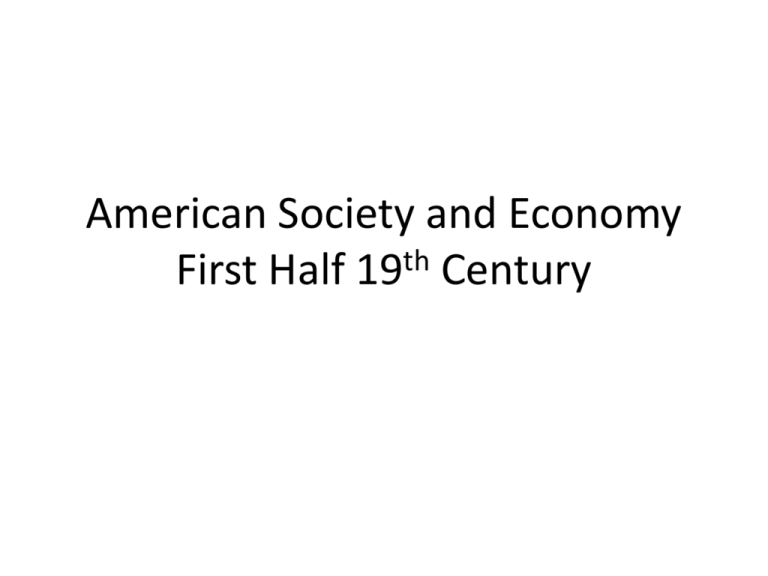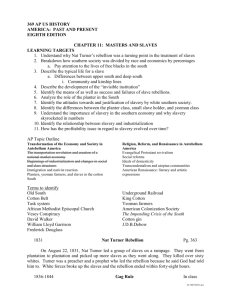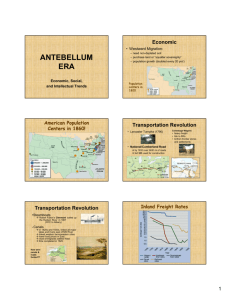10_ American Society and Economy
advertisement

American Society and Economy First Half 19th Century Themes • Transformations: Agriculture, Transportation, Industry and Urbanization • American Society: Religion and Reform Era Population Patterns • • • U.S. Population: 1790: 4 million: most east of Appalachians 1840: 17 million; 1/3 west of Appalachians People are slowly but surely migrating west Population grew in parts of “Old Northwest” to establish farms - Included states of: Ohio, Indiana, Illinois, Michigan, Wisconsin, and part of Minnesota Farm Economy • Most initially practiced subsistence agriculture • Men: Heavy work, like clearing land and plowing • Women: Many different chores (often endless) • Women began to sell eggs, butter, cheese, and other goods to supplement income Commercial Farming and Old Northwest • The Old Northwest became the center for American agriculture • Western farms had more room to grow unlike the east • Western farms also benefited from newer technologies: - McCormick Reaper (1840s) - John Deere Steel Plow (1837) Impact of Commercial Farming • Debt increased among farmers - Financial Panic of 1819 and 1837 which hurt many as credit tightened • Farmers were impacted by outside market forces (politics) Old Southwest Territory • Commercial farming and technology also impacted “Old Southwest” - Alabama, Mississippi, Louisiana, Tennessee and Arkansas • Settlement increased tremendously in mid 1820s and 1830s when cotton became the leading U.S. export • The South became the world’s largest supplier of cotton Old Southwest • It was the invention of the cotton gin in 1793 by Eli Whitney • Led to the cotton boom in the south • Easy separation of seeds from cotton • Demand for high slave labor Transportations Changes (Canals) • People pre 1820s moved place to place by horseback or boats down the river • Steamboats transformed transportation of goods and people via rivers • Canals made transporting western goods more practical • Increase in canal construction New York’s Erie Canal (1825) • • • • Linked Hudson River to Lake Erie 360 miles long 8 years to build Cost - $7 million Transportation Changes (Railroads) • Large boom in railroad construction in 1850s Railroads (1850) Rise of Industry • Lowell, Massachusetts was important center for textile manufacturing (wool) • Production in cloth increased from 4 million to 323 million yards between 1817 to 1843 • This began a movement to purchase readymade clothing rather than making it themselves Rise of Industry • 80% of factory workers in Lowell and Waltham textile mills were female • Long hours and hot, humid conditions were common • Many women could not ask for breaks out of fear of being fired • Owners – maximize profit Rise of Industry • In 1844, Samuel F.B. Morse demonstrated the potential of his telegraph by transmitting a series of dots and dashes that instantly conveyed an electronic message • By 1861, more than 5,000 miles of wire stretched across the continent to the Pacific Ocean, often alongside railroad tracks Urbanization • With the rise of industry a large amount of the population began to migrate towards industrial boom towns • Urbanization led to large towns that were not necessarily sea ports • By 1860 eight cities had populations over 100,000 • New York City’s population reached 800,000 by 1860 • Large inequality between rich and poor living in cities Gap between Rich and Poor • Boston - In 1833 the richest 4% owned 59% of city’s wealth • New York - in 1828 the richest 4% owned half the city’s wealth Immigrants and Persecution • Immigrants, looking for work, often faced persecution • Many of them being Irish Catholics who were persecuted daily by the pro-protestant majority • Native-born workers were resentful and believed large immigrant populations led to lower wages • Signs in front of factories read: - “NO IRISH NEED APPLY” Immigration in America • Many immigrants being Irish and Germans influenced the growth of the industrial North • The majority of European immigrants arrived in the U.S. in the 1850s Second Great Awakening • Began in New England in 1790s, but spread across the country in 1820 & 1830s • Camp meeting became common: - Large audiences listened to many different preachers - Speakers called on worshipers to ask for forgiveness and prepare for the Second Coming • The average attendance for services were in the thousands Second Great Awakening • Charles Finney: - Former lawyer and gifted speaker who received a sign from God - Advocated that anyone could achieve salvation - Unlike Jonathon Edwards, human nature wasn’t necessarily dominated by sin - Led Americans to reform and improve their society as a whole Religious and Utopian Communities ( 1800 – 1845) • Religion: Shakers • Numbered about 6,000 and established several communities • Goal: become self-sufficient • Well-known for their furniture and handicrafts • The movement peaked between 1820-1860 Era of Reform • There were many other groups attempting to improve society: - Temperance - Public Education - Opposition of Slavery - Women’s Rights Alcohol and Temperance • By the late 1820s, alcohol abuse was a major problem in the U.S. • A male drank 1 ½ pint of liquor each day • Religious leaders saw it as immoral • Factory owners were concerned about productivity and quality due to drunkenness Alcohol and Temperance • The American Society for the Promotion of Temperance began in 1826: - founded by Lyman Beecher, a minister who had been influenced by 2nd Great Awakening - Encouraged abstinence pledges - Lobbied states for prohibition of alcohol • Compared to the 1820s, rates of alcohol consumption dropped in half by 1840s • In 1836, leaders renamed the group the American Temperance Union Public Education • For many years public education was considered a family’s responsibility and not required • Horace Mann became a leading reformer in Massachusetts and the United States • Mann: 1st Secretary of the Massachusetts Board of Education in 1837 Public Education (Mann’s Reforms in Massachusetts) • School attendance became mandatory • Curriculum was standardized and emphasized practical education (not classics) • Many states adopted reforms and schools not only educated children, but helped immigrants as well Opposition to Slavery • Quakers, after the American Revolution, advocated abolition of slavery • American Colonization Society 1817 - Gradual emancipation of slaves with compensation for slave owners - Former slaves would be transported to Africa (Liberia) - Slavery was wrong, yet blacks were still inferior to whites. Both races cannot live side by side American Colonization Society (1817) • Joseph Jenkins Roberts, former slave, became first President of Liberia • About 12,000-15,000 migrated to Liberia • Capital city: Monrovia was named after James Monroe American Colonization Society (1817) • Paul Cuffe provided ships and money to former slaves hoping to travel to Liberia • Not many slaves earned their freedom; it was too expensive to compensate slaver owners • Many former slaves had no desire to live in Africa because many of them were born in the U.S. Opposition to Slavery • Black abolitionists were active as well: - David Walker and Fredrick Douglass • Whites such as William Lloyd Garrison joined the abolition movement • In 1831, Garrison wrote The Liberator, which called for the immediate abolition of slaves and the brutality of the South • Women: Angelina Grimke was born to a slaveholding family • She and her sister spoke to anti-slavery audiences encouraging them to join the movement Opposition to Slavery (Nat Turner’s Rebellion) • Nat Turner Rebellion 1831 • Location: Southampton, VA • A slave named Nat Turner led a rebellion of slaves and killed over 60 white men, women, and children • Turner and 16 slaves are captured and executed • Whites went all around the countryside killing any blacks they encountered and beheaded them Women’s Rights • Margaret Fuller received an education in the classics • Wrote women should be allowed to develop their own intellectual abilities • Other women’s rights advocates included Lucretia Mott and Elizabeth Cady Stanton Women’s Rights • Seneca Falls Convention (1848) - led by Stanton in New York - Women lacked rights to own property and vote - Declaration of Sentiments: “All men and women are created equal” Review • Ideas to consider: - Which transformations had the most impact on the nations development - Which reform movement was most successful?



